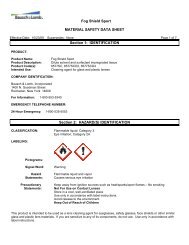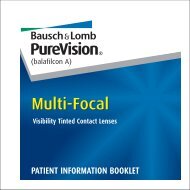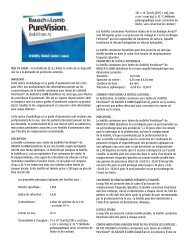Bausch & Lomb Perfecting vision, enhancing life for 150 years A ...
Bausch & Lomb Perfecting vision, enhancing life for 150 years A ...
Bausch & Lomb Perfecting vision, enhancing life for 150 years A ...
You also want an ePaper? Increase the reach of your titles
YUMPU automatically turns print PDFs into web optimized ePapers that Google loves.
Instrument Di<strong>vision</strong> – reflecting the company’s two main areas of research and<br />
development emphasis. The Ophthalmic Di<strong>vision</strong> specialized in eyeglass and<br />
sunglass lenses and frames and ophthalmic instruments. The Scientific<br />
Instrument Di<strong>vision</strong> produced everything from twelve-dollar student microscopes<br />
to advanced spectrophotometers and optical equipment <strong>for</strong> use in space<br />
exploration. Geographic expansion had meanwhile continued apace – by this<br />
time, <strong>Bausch</strong> & <strong>Lomb</strong> had subsidiaries in seven countries.<br />
In 1966, <strong>Bausch</strong> & <strong>Lomb</strong> made perhaps its most important decision since William<br />
<strong>Bausch</strong> decided to manufacture optical glass, by negotiating an agreement with<br />
an American company that held a license <strong>for</strong> soft contact lenses. Contact lenses<br />
made of glass had been in use since be<strong>for</strong>e World War II. So-called “hard”<br />
lenses, made of Lucite polymer, were introduced after the war; they were a vast<br />
improvement but were still too bulky <strong>for</strong> com<strong>for</strong>t and could be harmful to the eye.<br />
Gradually over twenty <strong>years</strong>, the Lucite lenses had become smaller and thinner,<br />
but few users could tolerate wearing them all day. By 1971, only about half a<br />
million of the estimated one hundred million Americans requiring <strong>vision</strong> correction<br />
were wearing contact lenses, and about half those patients dropped out in the<br />
first year of lens wear.<br />
<strong>Bausch</strong> & <strong>Lomb</strong> spent three <strong>years</strong> and more than three million dollars developing<br />
a viable soft contact lens from poly-HEMA, a patented hydrogel material invented<br />
by Otto Wichterle, a Czechoslovakian chemist who had created the first soft<br />
contact lenses in 1961. In 1969, just as <strong>Bausch</strong> & <strong>Lomb</strong> was ready to release its<br />
new product, the United States Food and Drug Administration (FDA) classified<br />
soft contact lenses as a drug, raising a host of new regulatory hurdles to be<br />
overcome. Two more <strong>years</strong> of testing and development went into the product<br />
be<strong>for</strong>e the FDA approved <strong>Bausch</strong> & <strong>Lomb</strong>’s Soflens contact lenses <strong>for</strong> sale to<br />
consumers in March 1971. In less than six months, sales reached a million<br />
dollars and, be<strong>for</strong>e a year was out, sales topped ten million dollars.<br />
A few early problems were reported with the soft contact lenses, including<br />
bacterial infections resulting from their use, and some eye care professionals<br />
were reluctant to prescribe and fit the new product. Ultimately, however, <strong>Bausch</strong><br />
& <strong>Lomb</strong>’s soft contact lenses revolutionized the <strong>vision</strong> correction industry and the<br />
company. Within three <strong>years</strong>, a number of competitors had entered the market,<br />
but <strong>Bausch</strong> & <strong>Lomb</strong>’s early lead was hard to overcome. By 1974, an estimated<br />
one million patients wore Soflens contact lenses, and five <strong>years</strong> later, the Soflens<br />
brand retained a commanding share of the soft contact lens market. The firm<br />
also sold huge quantities of lens cleaning and soaking solutions, capturing<br />
market leadership <strong>for</strong> these products as well. In 1982, a company executive<br />
remarked that the soft contact lens alone was responsible <strong>for</strong> making <strong>Bausch</strong> &<br />
<strong>Lomb</strong> a Fortune 500 company, a status it achieved in 1975.






